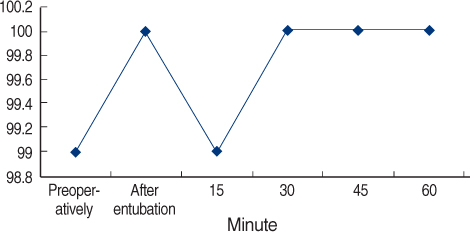J Breast Cancer.
2009 Mar;12(1):32-35. 10.4048/jbc.2009.12.1.32.
Intraparenchymal Methylene Blue Injection for Sentinel Lymph Node in Breast Cancer Patients does not Interfere with the Pulse Oximetry Readings
- Affiliations
-
- 1Department of General Surgery; Breast Division, Istanbul University Cerrahpasa Medical School, Istanbul, Turkey. memetoplantisi@yahoo.com
- 2Department of Anesthesiology and Reanimation, Istanbul University Cerrahpasa Medical School, Istanbul, Turkey.
- 3Department of Plastic, Reconstructive and Aesthetic Surgery, Istanbul University Cerrahpasa Medical School, Istanbul, Turkey.
- 4Department of Plastic, Reconstructive and Aesthetic Surgery, Istanbul University Istanbul Medical School, Istanbul, Turkey.
- KMID: 2286576
- DOI: http://doi.org/10.4048/jbc.2009.12.1.32
Abstract
- PURPOSE
Alteration in oxygen saturation is a side effect of the dye used in sentinel lymph node biopsy. The object of this study was to determine the possible effects of methylene blue on the oxygen saturation in patients undergoing sentinel lymph node biopsy. METHODS: The complete peroperative records of 148 patients who underwent sentinel lymph node biopsy with intraparenchymal injection of methylene blue were reviewed. The data reviewed included the preinjection pulse oximeter saturation readings and the postinjection values until the readings returned to the preoperative levels in the postanesthesia care unit. RESULTS: The pulse oximetry values were recorded preoperatively, after intubation and, at 15, 30, 45, and 60 minutes of the operation. The results showed that methylene blue did not cause any significant changes in oxygen saturation levels. CONCLUSION: We suggest that methylene blue might be preferable for the patients with concomitant disease, and for whom close monitoring of their oxygen saturation is required.
Keyword
MeSH Terms
Figure
Reference
-
1. Veronesi U, Paganelli G, Viale G, Luini A, Zurrida S, Galimberti V, et al. A randomized comparison of sentinel-node biopsy with routine axillary dissection in breast cancer. N Engl J Med. 2003. 349:546–553.
Article2. Krag D, Weaver D, Ashikaga T, Moffat F, Klimberg VS, Shriver C, et al. The sentinel node in breast cancer--a multicenter validation study. N Engl J Med. 1998. 339:941–946.
Article3. Thevarajah S, Huston TL, Simmons RM. A comparison of the adverse reactions associated with isosulfan blue versus methylene blue dye in sentinel lymph node biopsy for breast cancer. AM J Surg. 2005. 189:236–239.
Article4. Veronesi U, Paganelli G, Galimberti V, Viale G, Zurrida S, Bedoni M, et al. Sentinel-node biopsy to avoid axillary dissection in breast cancer with clinically negative lymph-nodes. Lancet. 1997. 349:1864–1867.
Article5. Masannat Y, Shenoy H, Speirs V, Hanby A, Horgan K. Properties and characteristics of the dyes injected to assist axillary sentinel node localization in breast surgery. Eur J Surg Oncol. 2006. 32:381–384.
Article6. Simmons R, Thevarajah S, Brennan MB, Christos P, Osborne M. Methylene blue dye as an alternative to isosulfan blue dye for sentinel lymph node localization. Ann Surg Oncol. 2003. 10:242–247.
Article7. Simmons RM, Smith SM, Osborne MP. Methylene blue dye as an alternative to isosulfan blue dye for sentinel lymph node localization. Breast J. 2001. 7:181–183.
Article8. Blessing WD, Stolier AJ, Teng SC, Bolton JS, Fuhrman GM. A comparison of methylene blue and lymphazurin in breast cancer sentinel node mapping. AM J Surg. 2002. 184:341–345.
Article9. Scheller MS, Unger RJ, Kelner MJ. Effects of intravenously administered dyes on pulse oximetry readings. Anesthesiology. 1986. 65:550–552.
Article10. Heinle E, Burdumy T, Recabaren J. Factitious oxygen desaturation after isosulfan blue injection. Am Surg. 2003. 69:899–901.11. McMorrow RC, Mythen MG. Pulse oximetry. Curr Opin Crit Care. 2006. 12:269–271.
Article12. Saito S, Fukura H, Shimada H, Fujita T. Prolonged interference of blue dye "patent blue" with pulse oximetry readings. Acta Anaesthesiol Scand. 1995. 39:268–269.
Article13. Kessler MR, Eide T, Humayun B, Poppers PJ. Spurious pulse oximeter desaturation with methylene blue injection. Anesthesiology. 1986. 65:435–436.
Article14. Piñero A, Illana J, García-Palenciano C, Cañizarese F, Canteras M, Cañadillas V, et al. Effect on oximetry of dyes used for sentinel lymph node biopsy. Arch Surg. 2004. 139:1204–1207.
Article15. Momeni R, Ariyan S. Pulse oximetry declines due to intradermal isosulfan blue dye: a controlled prospective study. Ann Surg Oncol. 2004. 11:434–437.
Article16. El-Tamer M, Komenaka IK, Curry S, Troxel AB, Ditkoff BA, Schnabel FR. Pulse oximeter changes with sentinel lymph node biopsy in breast cancer. Arch Surg. 2003. 138:1257–1260.
Article17. Lee BB. Pulse oximetry and patent blue vital dye. Acta Anaesthesiol Scand. 2003. 47:491.
Article18. Kieckbusch H, Coldewey SM, Hollenhorst J, Haeseler G, Hillemanns P, Hertel H. Patent blue sentinel node mapping in cervical cancer patients may lead to decreased pulse oximeter readings and positive methaemoglobin results. Eur J Anaesthesiol. 2008. 25:365–368.
Article19. Vieira SC, Sousa RB, Tavares MB, de Abreu BA, Ibiapina JO, de Sousa Oliveira AK, et al. Changes in pulse oximetry after patent blue dye injection into the uterine cervix. Ann Surg Oncol. 2008. 15:2862–2866.
Article20. Golshan M, Nakhlis F. Can methylene blue only be used in sentinel lymph node biopsy for breast cancer? Breast J. 2006. 12:428–430.
Article21. Nour A. Efficacy of methylene blue dye in localization of sentinel lymph node in breast cancer patients. Breast J. 2004. 10:388–391.
Article22. Tsopelas C, Sutton R. Why certain dyes are useful for localizing the sentinel lymph node. J Nucl Med. 2002. 43:1377–1382.
- Full Text Links
- Actions
-
Cited
- CITED
-
- Close
- Share
- Similar articles
-
- Effects of Isosulfan Blue and Methylene Blue on Oxygen Saturation by Pulse Oximetry in Sentinel Lymph Node Biopsy
- Methylene Blue for Localization of Sentinel Lymph Nodes in Breast Cancer: A Comparison with Isosulfan Blue
- False Low Pulse Oximetry Reading following a Peritumoral Injection of 1% Isosulfan Blue Dye in a Patient with Breast Cancer
- Decrease in Pulse Oximeter Readings Following Injection of Isosulfan Blue Dye
- Value of Sentinel Lymph Node Biopsy in Breast Cancer Patients with Previous Excisional Biopsy


